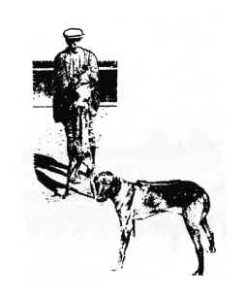The Rhodesian Ridgeback originated in Southern
Africa where the early European settlers mated their imported
sporting breeds with the small, fierce hunting dogs owned by the
Hottentots in order to produce a guard/hunting dog ideally suited to
local conditions. The Hottentot Hunting Dog had a ridge of hair
along its spine running in a reverse direction to the rest of the
coat and this particular characteristic became a feature of the
cross matings between the European breeds and the native dogs.
These “Ridgebacks” were used as functional all
purpose guard and hunting dogs and it was found that they surpassed
any other breed when hunting lions. During the late 19th century the
reputation of “Ridgebacks” in this field became established through
the exploits of a famous big game hunter in Rhodesia named Cornelius
Van Rooyen, who had a pack of these ridged dogs. Van Rooyen’s dogs
were very similar to today’s Rhodesian Ridgeback.
Cornelius van Rooyen
with two of his Ridgebacks, extracted from Mylda L Aresenis’ “Ridged Dogs in Africa”.
It was not intended that the Ridgeback should
actually kill the lion but rather keep it at bay until the hunter
could shoot it. Ridgebacks would, however, kill lion cubs without
hesitation and pull down lesser game with ease.
The Standard of the
Breed was drawn up following a meeting of “Ridgeback” owners in
Bulawayo in 1922 and this was accepted by the South African Kennel
Union (now the Kennel Union of Southern Africa) in 1924. The
Standard borrowed much from the Dalmatian Standard and envisages a
“strong, muscular and active dog, symmetrical in outline and
capable of great endurance, with a fair amount of speed”.

One of the
earliest Rhodesian Ridgebacks was “Eskdale Dingo” (registered on
16th March 1926) owned and bred by Mr FA Barnes of Eskdale Kennels –
photo extracted from Major Hawley’s “The Rhodesian Ridgeback – The
Origin, History and Standard”
Rhodesian Ridgebacks have adapted well to modern
day life. They are highly intelligent and have a loving, loyal
temperament with those they know, but are distinctly off-hand with
strangers. They are good guard dogs, but do not bark unless there is
a reason. They are quite happy to lie about all day doing nothing
and yet are enthusiastic about walks or expeditions.
No single breed of dog suits everybody and there
are aspects of the Ridgeback character which would not endear them
to some people. They can be strong willed, determined, independent
and extremely obstinate. There is nothing slavish about a Ridgeback
– the man/Ridgeback relationship tends to be one of partners rather
than a master/servant situation. He never forgets love and
understanding, nor does he lightly forgive harsh treatment. He is a
dog of noble bearing whose physical attributes should reflect his
role as guardian, companion and hunter.
The adults do not require vast amounts of food.
They are hardy dogs and routine care consists of checking the ears,
cutting the nails, weekly grooming and regular worming an
inoculations.

